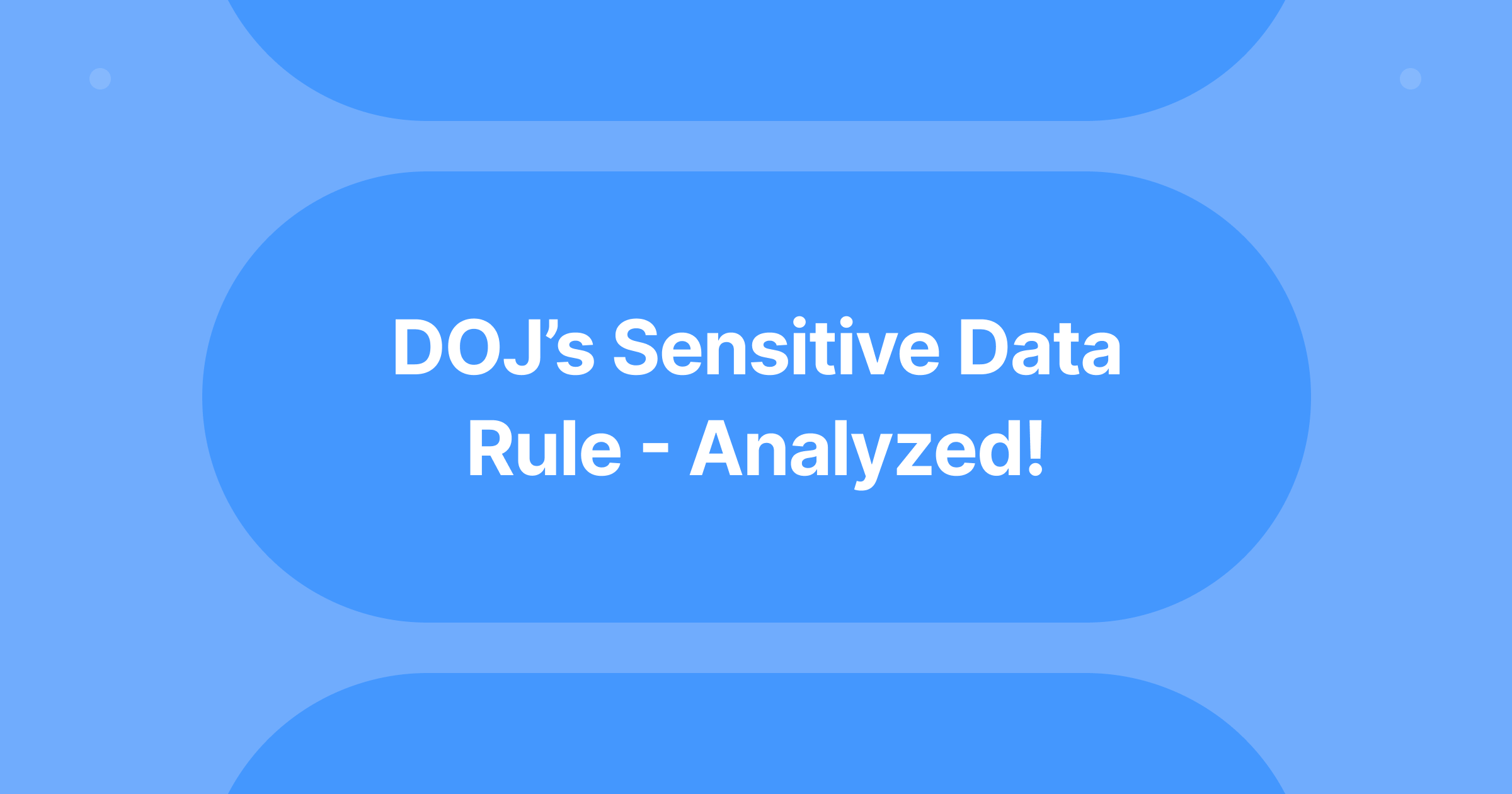DOJ’s Sensitive Data Rule - Analyzed!
The Department of Justice’s new Sensitive Data Rule marks one of the most significant shifts in federal compliance and national security oversight in recent years. Designed to curb the risk of sensitive personal, corporate, and national security information flowing into the hands of foreign adversaries, the rule dramatically expands obligations for businesses that handle—or indirectly expose—protected data.

In effect, organizations must now treat sensitive data not only as a privacy concern, but as a national security asset. This is no longer the domain of compliance officers alone—it’s a cross-enterprise challenge that demands executive-level ownership.
The New Compliance Landscape
The Sensitive Data Rule creates strict oversight for any transaction, data flow, or technology integration that could allow sensitive U.S. data to be accessed by a “country of concern” or an unvetted foreign entity. This includes:
- Direct sales or transfers of sensitive datasets
- Third-party service integrations where foreign ownership or access exists
- AI and machine learning tools that ingest, train on, or process sensitive data
Given the DOJ’s focus, violations could trigger civil and criminal penalties, contract restrictions, and—in some cases—forced divestiture of affected assets.
Why AI Exponentially Increases the Risk
AI agents have transformed how companies process, enrich, and derive value from data. But they’ve also made data pathways more opaque. In many organizations:
- SaaS applications with embedded AI send data to undisclosed sub-processors.
- AI models are retrained in the background, creating derivative datasets that may be stored or processed overseas.
- Shadow AI—unvetted tools adopted by employees—intersects with sensitive datasets without formal approval or monitoring.
This complexity means a company can unintentionally create a DOJ enforcement risk simply by allowing an AI feature in an otherwise legitimate SaaS platform.
Who Must Lead the Charge Internally
The Sensitive Data Rule is not just an IT issue—it’s an enterprise resilience issue. Ownership must span:
- Chief Information Security Officer (CISO) – Oversees secure architecture and ensures AI data flows are fully mapped and controlled.
- Chief Privacy Officer (CPO) – Ensures sensitive data categories are properly classified and that transfer restrictions align with the DOJ rule.
- General Counsel / Chief Legal Officer – Interprets the rule, advises on contractual and jurisdictional risks, and engages external counsel where needed.
- Chief Compliance Officer (CCO) – Embeds DOJ compliance into corporate policy and training.
- Procurement & Vendor Risk Management Leads – Vet all third parties—including AI vendors—for DOJ-restricted affiliations.
- Data Governance Officer – Maintains real-time inventories of sensitive data flows, including AI-driven exchanges.
A Practical 6-Step DOJ Compliance Implementation Plan
1. Conduct a Comprehensive Data Flow Audit
Identify where sensitive data originates, how it’s processed, and every endpoint—including AI tools and sub-processors. Shadow AI must be uncovered and cataloged.
2. Classify Data According to DOJ Sensitivity Criteria
Tag datasets as high-risk if they involve personal identifiers, geolocation, health, biometric, or other DOJ-listed sensitive fields. Flag datasets that could carry national security implications.
3. Map and Risk-Score Third-Party Relationships
Cross-reference vendors, partners, and AI service providers against DOJ country-of-concern lists. Score each based on jurisdiction, ownership, and data access scope.
4. Implement Real-Time Data Governance Controls
Deploy systems that can intercept, redact, block, or route data in motion—especially to AI platforms—when they fail DOJ compliance checks.
5. Update Contracts and Policies
Include DOJ-aligned restrictions in vendor agreements, data processing addendums, and employee usage policies. Require contractual guarantees on data residency and non-transfer.
6. Establish Continuous Monitoring and Incident Response
Automate surveillance of data flows to detect and remediate violations immediately. Integrate alerting with security operations for rapid containment.
How a Modern Data Governance Platform Solves the DOJ Compliance Dilemma
The complexity of AI-driven data exchange makes manual compliance impractical. A capable compliance platform should offer:
- Automated AI Vendor Discovery – Detects all AI and SaaS services touching sensitive datasets, including unapproved tools.
- Data Classification at Scale – Automatically identifies DOJ-relevant sensitive fields, even in unstructured formats.
- Geolocation Tracking – Pinpoints where data is stored or processed, down to the jurisdiction level.
- Policy-Based Enforcement – Blocks or redacts data in transit if it’s headed to a restricted location or entity.
- Agentless Deployment – Avoids operational friction by integrating at the network and API layers without rewriting code.
- Continuous Reporting – Maintains audit-ready logs of all data transactions for DOJ review or internal assurance.
Such a system transforms compliance from a reactive, investigative function into a proactive, enforced safeguard—preventing violations before they occur.
The Bottom Line
The DOJ’s Sensitive Data Rule signals a new era where data security and national security are inseparable. With AI multiplying the number and opacity of third-party data flows, organizations cannot afford blind spots. Leadership must treat sensitive data as both a regulatory and geopolitical risk vector.
By combining robust data classification, AI vendor discovery, geographic flow tracking, and real-time enforcement, companies can meet DOJ requirements while still harnessing AI’s benefits—securely, compliantly, and confidently.

